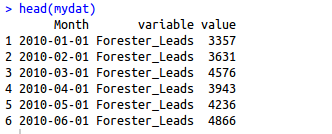Lets say that we estimated a linear regression model on time series data with lagged predictors. The goal is to estimate sales as a function of inventory, search volume, and media spend from two months ago. After using the lm function to perform linear regression, we predict sales using values from two month ago.
frmla <- sales ~ inventory + search_volume + media_spend mod <- lm(frmla, data=dat) pred = predict(mod, values, interval="predict")
If this model is estimated weekly or monthly, we will eventually want to understand how well our model did in predicting actual sales from month to month. To perform this task, we must regularly maintain a spreadsheet or data structure (RDS object) with actual predicted sales figures for each time period. That data can be used to create line graphs that visualize both the actual versus predicted values.
Here is what the original spreadsheet looked like.

Transform that data into long format using whatever package you prefer.
library(reshape) mydat = melt(d1)
This will provide a data frame with three columns.

We can utilize the ggplot2 package to create visualizations.
ggplot(mydat, aes(Month, value, group=variable, colour=variable)) +
geom_line(lwd=1.05) + geom_point(size=2.5) +
ggtitle("Sales (01/2010 to 05/2015)") +
xlab("Date") + ylab("Sales") + ylim(0,30000) + xlab(" ") + ylab(" ") +
theme(legend.title=element_blank()) + xlab(" ") +
theme(axis.text.x=element_text(colour="black")) +
theme(axis.text.y=element_text(colour="black")) +
theme(legend.position=c(.4, .85))

Above is an example of what the final product could look like. Visualizing predicted against actual values is an important component of evaluating the quality of a model. Furthermore, having such visualization will be of value when interacting with business audiences and “selling” your analysis.